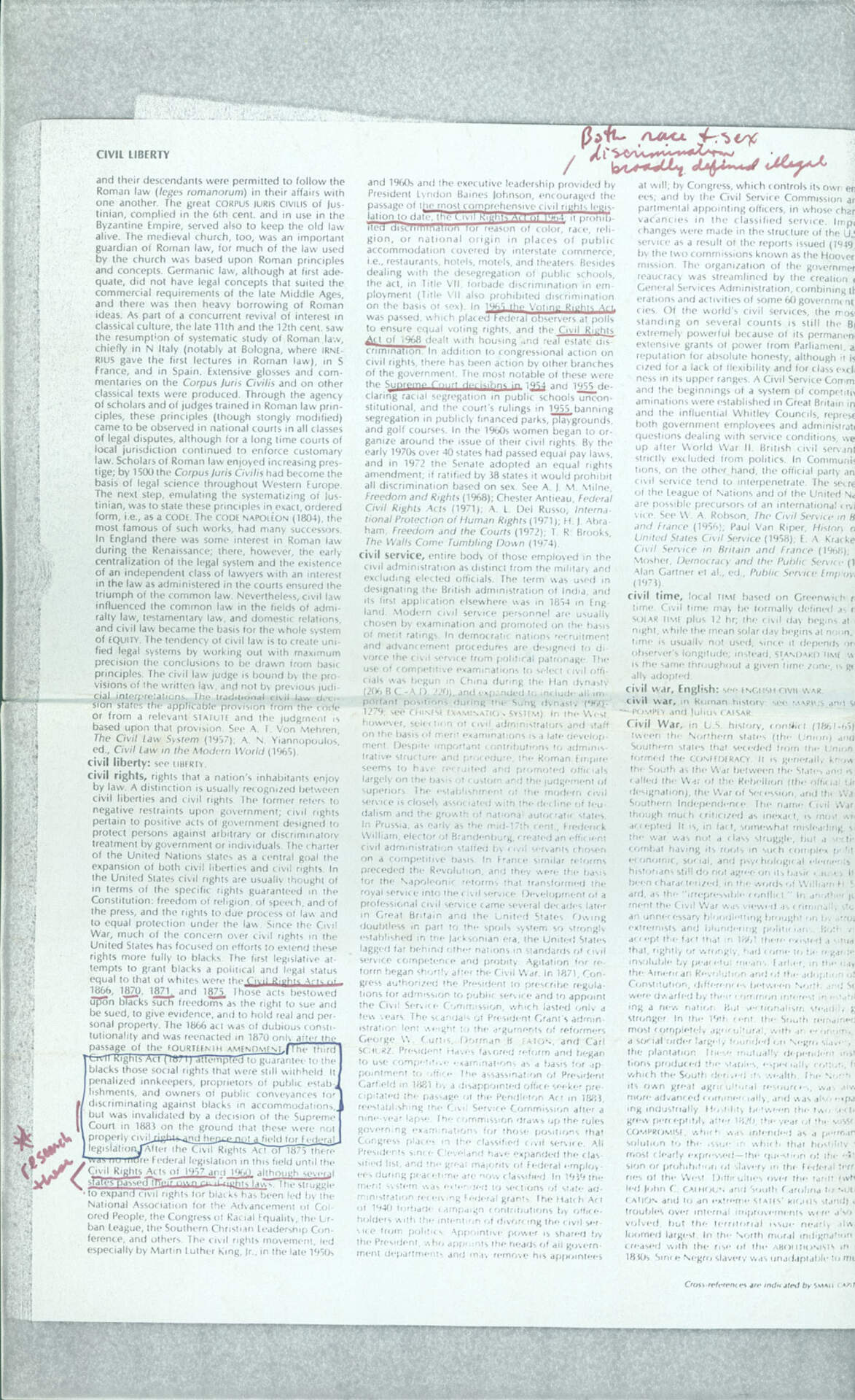Paul Sharits (1943-1993)Civil Liberty
Copied article on paper with annotations
14 x 8 1/2 inches
Gift of Christopher and Cheri Sharits, 2006
CIVIL LIBERTY
And their descendants were permitted to follow the Roman law (leges romanorum) in their affairs with one another. The great corpus Juris Civilis of Justinian, complied in the 6th cent. and in use in the Byzantine Empire, served also to keep the old law alive. The medieval church, too was an important guardian of Roman law, for much of the law used by the church was based upon Roman principles and concepts. Germanic law, although at first adequate, did not have legal concepts that suited the commercial requirements of the late Middle Ages, and there was then heavy borrowing of Roman ideas. As part of a concurrent revival of interest in classical culture, the late 11th and 12th century saw the resumption of systematic study of Roman law, chiefly in N Italy (notably at Bologna, where Irnerius gave the first lectures in Roman law), in S France, and in Spain. Extensive glosses and commentaries on Corpus Juris Civilis and on other classical texts were produces. Through the agency of scholars and of judges trained in Roman law principles, these principles (through stongly modified) came to be observed in national courts in all classes of legal disputes , although for a long time courts of local jurisdiction continued to enforce customary law. Scholars of Roman law enjoyed increasing prestige; by 1500 the Corpus Juris Civilis had become the basis of legal science throughout Western Europe. The next step, emulating the systematizing of Justinian, was to state these principles in exact, ordered from, i.e., as CODE NAPOLEON (1804), the most famous of such works, had many successors. In England there was some interest in Roman law during the renaissance; there, however, the early centralization of the legal system and the existence of an independent class of lawyers with an interest in the law as administered in the courts ensured the triumph of the common law. Nevertheless, civil law influenced the common law in the fields of admiralty law, testamentary law, and domestic relations, and civil law became the basis for the whole system of EQUITY. The tendency of civil law is to create unified legal systems by working out with maximum precision the conclusions to be drawn from basic principles. The civil law judge is bound by the provisions of the written law, and not be previous judicial interpretations. The traditional civil law decision states the applicable provision from the code or from a relevant STATUTE and the judgment is based upon that provision. See A. T. Von Mehran, The Civil Law System (1957); A. N. Yiannopoulos, ed., Civil Law in the modern World (1965).
Civil liberty: see LIBERTY
Civil Rights, rights that a nation’s inhabitants enjoy by law. A distinction is usually recognized between civil liberties and civil rights. The former refers to negative restraints upon government; civil rights pertain to positive acts of government designed to protect persons against arbitrary or discriminatory treatment by government or individuals. The charter of the United Nations states as a central goal the expansion of both civil liberties and civil rights. In the United States civil rights are usually thought of in terms of specific rights guaranteed in the Constitution: freedom of religion, of speech, and of the press, and the rights to due process of law and to equal protection under the law. Since the Civil War, much of the concern over civil rights in the United States has focused on efforts to extend these rights more fully to blacks. The first legislative attempts to grant blacks a political and legal status equal to that of whites were the Civil Rights Acts of 1866, 1873, 1871, and 1875. Those acts bestowed upon blacks such as freedoms as the right to sue and be sued, to give evidence, and to hold real and personal property. The 1886 act was of dubious constitutionality and was reenacted in 1870 only after a passage of the FOURTEENTH AMENDMENT. The third Civil Rights Act (1871) attempted to guarantee to the blacks those social rights that were still withheld. It penalized innkeepers, proprietors of public establishments, and owners of public conveyances for discriminating against blacks in accommodations, but was invalidated by a decision of the Supreme Court in 1883 on the ground that these were not properly civil rights and hence not a field for Federal legislation. [*Research these]. After the Civil Rights Act of 1875 there was no more Federal Legislation in this field until the Civil Rights Acts of 1957, and 1960 although several states passed their own civil rights laws. The struggle to expand civil rights for blacks has been led by the National Association for the Advancement of Colored People, the Congress of Racial Equality, the Urban League, the Southern Christian Leadership Conference, and others. The civil rights movement, led especially by Martin Luther King Jr., in the late 1950s and 1960s and the executive leadership [Both race and sex discrimination broadly defined illegal] provided by President Lyndon Baines Johnson, encouraged the passage of the most comprehensive civil rights legislation to date, the Civil Rights Act of 1964: it prohibited discrimination for reason of color, race, religion, or national origin in places of public accommodation covered by interstate commerce, i.e.c, restaurants, hotels, motels, and theaters. Besides dealing with the desegregation of public schools, the act, in Title VII, forbade discrimination in employment (Title VII also prohibited discrimination on the basis of sex). In 1956 the Voting Rights Act was passed, which placed Federal observers at polls to ensure equal voting rights, and the Civil Rights Act of 1968 dealt with housing and real estate discrimination. In addition to congressional action on civil irghts, there has been action by other branches of the government. The most notable of these were the Supreme court decisions in 1954 and 1955 declaring racial segregation in public schools unconstitutional, and the court’s rulings in 1955 banning segregation in publicly financed parks, playgrounds, and golf courses. In the 1960s women began to organize around the issue of their civil rights. By the early 1970s over 40 states had passed equal pay laws, and in early 1972 the Senate adopted an equal rights amendment; if ratified by 38 states it would prohibit all discrimination based on sex. See A. J. M. Milne, Freedom and Rights (1968); Chester Antieau, Federal Civil Rights Act (1971); A. L. Del Russo, International Protection of Human Rights(1971); H. J. Abraham, Freedom and the Courts (1972); T. T. Brooks, The Walls Come Tumbling Down (1974).
Civil service, entire body of those employed in the civil administration as distinct from the military and excluding elected officials. The term was used in designating the British administration of India, and its first application elsewhere was in 1854 in England. Modern civil service personnel are usually chosen by examination and promoted on the basis of merit ratings. In democratic nation’s recruitment and advancement procedures are designed to divorce the civil service from political patronage. The use of competitive examinations to select civil officials…


